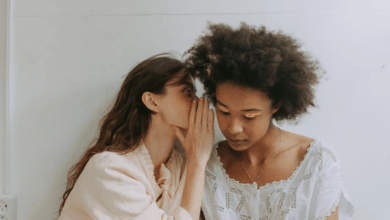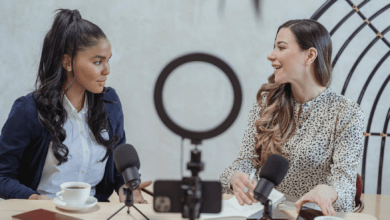
It’s true that lesbians have communicated their lesbianism in covert ways throughout history, including in the way they dress. Over time, lesbians developed a style pool, a fashion system, to signal their lesbianism in a safer, secret way. The “lesbian style” might appear stereotypical, but that’s because heterosexuals have turned it into a joke. The recent New York Post article, which went somewhat viral in lesbianland, ‘Dressing like a lesbian’ is sexy, ‘powerful’ new trend, fashion expert says, is no exception.
Stereotypes vs. Signals
Stereotypes ‘other’ marginalized people. That doesn’t change if the stereotypes appear to be true. The stereotype that lesbians are mean, for example, puts a sinister twist on the resilience we’ve built, existing as women uninterested in men in a patriarchal world where male desire, male sexual dominance, is the focus. We are viewed as “mean” because we don’t compromise, sexually, with heterosexual men.
Stereotypes and signifiers aren’t the same, either. Dressing Dykes, a blog by lesbian fashion historian Eleanor Medhurst, reads:
“I think that these two things – stereotypes and signifiers – are related, but definitely not the same when placed in the lesbian context. While some things may be and remain stereotypes, they do not always work as signifiers, purely because they are worn by many more people than lesbians alone. One example of this is, of course, sensible footwear. Sensible footwear, or comfortable shoes: the foundations, literally, of many a lesbian’s journey through the world. Photographs, personal stories and jokes alike all attest to this, as do my fiancée’s Birkenstocks and Doc Martens, lined up behind me as I type.”
Do lesbians wear sensible shoes because we, unlike heterosexual women, were born with an added desire for comfort? No. If anything, while lesbians aren’t immune from the male gaze, we’re not trying to turn the average man on through hyper-feminine, uncomfortable shoes and clothing.
Lesbians can be — and often are — attracted to gender neutrality or female masculinity, so it’s only logical that we have a penchant for sensible shoes. However, because we aren’t dressing for men, and women typically want their partner or love interest to be comfortable, sensible shoes submerge into our gaydar.
You’re at the club, say. You see a woman and think “that woman is wearing sensible shoes, no makeup, and neutral clothing, when women around her wear heels and have Kim K contouring: I wonder if she’s like me.” No, that doesn’t mean she’s definitely a lesbian. But the sensible shoes, the context, and combination with what else she wears, indicate who she is, who she’s trying to present herself as and who she’s presenting herself to. Fashion isn’t coincidental. Unless you’re like me and rarely get out of tracksuit pants — or the house.
In Modern Pink (1991), Daphne Fox Calgary nodded to the lesbian signal of sensible shoes while also acknowledging that lesbianism is female homosexuality, not what’s on our feet: “And we do all love women, don’t we? So that makes us all sisters; those in Hush Puppies, those in high heels, those in black leather boots, those in orthopaedic oxfords, and even those who are presently barefoot and pregnant.”
Lesbians wearing sensible shoes can be a signal, coincidence or a result of not wanting male attention. Either way, we signal ourselves through fashion, consciously or not, and straight people stereotype us for it.
If straight people aren’t laughing at our fashion then they’re co-opting it as some ‘sexy’, fetishistic power move. The New York Post article doesn’t only stereotype lesbians, it dehistoricizes and misrepresents our intricate web of clothing signals. Let’s take a closer look.
Analyzing the Article
Once again, lesbians are called “queer” in the first line: “Lesbi-honest, queer fashion is totally in!” ‘Queer’ might appeal to lesbians as some revolutionary war cry, but when straight people use and abuse it, they use and abuse us. The fact ‘queer’ is embraced by powerholders instantly devenomizes it. Many of us rejected it even when it held potential power as some ‘revenge of the other’ movement because ‘queer’ is defined by otherness. It relies on perpetuating our suspected ‘abnormality’ to exist as a concept.
Apparently, the “stereotypical lesbian look” is being leant into by non-lesbians due to its “anti-glam” elements. So our fashion is “cool” because it’s cool to be ‘other’, to be unfashionable. Lesbianism is seen as a political choice to reject mainstream society, not a sexual orientation that’s rejected because it challenges heteronormativity. Self-identified “queer” people making homosexuality a fun and rebellious identity, rather than a neutral and acceptable reality, is partly to blame for this widespread rhetoric.
‘Lesbian fashion’ making its way to straight influencer Instagrams is equated with genuine acceptance. The article quotes Jill Gutowitz, who believes that “seeing lesbian fashion mainstreamed feels validating, like we were right this whole time.” Jill admits, in her article on Harper’s Bazaar, that despite this “validation” by the straights, “seeing a straight-identifying woman wearing overalls, Tevas, and a bandana is somewhat disorienting.” Lesbians begging for crumbs of straight validation, even if it plays into stereotypes and fetishization, is uncomfortable to read.
Equating seeing straight women in overalls and a bandana with validation and “empowerment” is not actual, material, acceptance. It’s not power. “Seeing lesbian fashion elevated has emboldened me–whether out of pure joy or pure spite–to become the most lesbian lesbian who has ever lesbianed,” she writes. Question: has being the “most lesbian” — as if it’s a competition — got anything to do with fashion? You’re a lesbian or you’re not. Sure, I love lesbian fashion signals. But seeing a straight women wearing a tailored suit doesn’t scream ‘LESBIAN LIBERATION!’ to me. Viewing it as ’empowering’ lesbians screams “I still want the validation from hot straight girls in high school who ridiculed me for being against the grain.”
Straight women embracing supposedly lesbian-only fashion choices are viewed as an opportunity to enlist them in our lesbian army. Actual lesbian Kristen Stewart, was “basically an organized gay recruitment effort,” when, in her ‘Spencer’ press tour, she was “clad with tweed jackets, wide-leg pants and two-piece skirt suits,” according to Gutowitz. In the same breath, the New York Post article mentioned Cate Blanchett, not a lesbian, “for shamelessly slaying in stylish suits.” How can a straight woman be advocating for lesbianism by wearing a suit? How is Kristen Stewart enlisting lesbians by being a lesbian and wearing what she wants? Is lesbianism merely a tweed jacket and Doc Martens?
Should straight women feel entitled to, or equated with, lesbianism by wearing two-piece skirt suits, like Kristen? “It-girls,” Bella Hadid and Kendall Jenner, have apparently “stunned in sapphic swag”: Jenner wearing “[a] striped sleeveless knit, loose slacks and mahogany loafers,” and Hadid “a pair of dark culottes with matching jacket, a red tie and sunglasses while in Paris.” Anyone would think 2022 was the first year women challenged hyper-femininity. The ‘80s, anyone? What about female punk bands in the ‘90s?
Then the New York Post article takes a dangerous turn into ‘lesbians are manly’ territory. Exemplifying how ‘sapphic’ straight women can be, the article quotes Hadid, in an interview with Vogue: “I dress like a little boy…You couldn’t catch me in a dress willingly at this point in my life…I look outside and I see a hundred people dressed exactly like me, just because of what Instagram is.”
The lesbian = man doesn’t stop there. The “dressing like a lesbian” trend “has taken over straight women on TikTok,” according to the article, evident in the “hoodies and loose-fitting sweats.” Quoting TikToker @Bodmonzaid, who said “Why do I wear guy clothes and look like this all the time?”, the article equates neutral, comfortable clothing with male fashion and, by extension, lesbian fashion.
It only gets worse. The article quotes TikTok user @Emma_Thornblad, who said “Thinking about how I got my [boyfriend] in my ‘dressing like a [masculine] lesbian & getting hit on by every woman’ era,” uncritically. They just left it like that. Yep, the editor didn’t think to themselves “hey, this is a little questionable [a straight woman contemplating how she pulled a man when she appears like a repulsive butch], maybe we should leave it out or, at the very least, critique it.”
Jill Gutowitz at least mentions how straight women adopting supposedly ‘lesbian styles’, and being admired for it, is a far cry from what lesbians experience, but she suggests we were only shamed for our “anti-glam” appearance and sexual orientation once upon a time: “While I feel joyful that lesbian fashion is so beloved today, part of me also feels resentful…Androgynous looks that lesbians were once shamed for, that were once visual identifiers among our own community, are now Urban Outfitters staples.”
Straight women can overthrow hyperfeminine fashion and not be nodding to lesbianism. However, because “queer” is now somewhat fashionable, despite the conceptual movement claiming to be anti-trend — like how it claims to be anti-capitalist and yet is embraced by corporations — some straight celebrities are going to be inspired by it. “Queer” being fashionable doesn’t mean homosexuality’s accepted. It doesn’t mean homophobia’s over. Straight women wearing combat boots and leather does not mean that lesbianism is cool, and “cool” doesn’t mean liberated. “Queer” and its theories have turned us into a consumerist object to try on for a rebellious, attention-seeking moment, before going home and making dinner for the hubby. What’s fashionable does not equate to what’s truly free.





